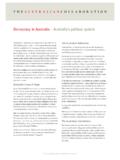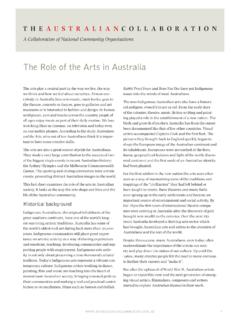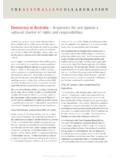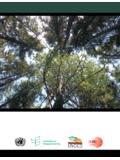Transcription of Land Degradation - Australian Collaboration
1 TheAusTrAliAnCollAborATion A Collaboration of National Community is land Degradation ?There are many definitions of land Degradation but all share the idea that detrimental changes to the condition of land have occurred because of the many ways land has been developed and used. The term Degradation is used to describe changes that are additional to those occurring naturally and carries with it the notion of change that is undesirable and brought about by humans. land degrada-tion then refers to chemical and biophysical changes in land that reduce both its quantity and quality. Frequently, these changes are linked to a reduction in the productive capacity of land and its economic term land generally includes rocks, soils and miner-als and the vegetation and animal habitats it supports the combination of all these elements form landscapes. The condition of land or land health invokes the concept of ecosystems the interactions and connections between the living and non-living components of the environment.
2 In degraded land , where ecosystems have been changed, the altered ecosystems continue to function but have a reduced capacity to supply the goods and services we are seeking, for example, food, habitat for threatened species and landscape addition to providing for the physical needs of increasing populations, land has a spiritual and cultural significance for many but in particular Indigenous people. The changes in the condition of land following settlement by Europeans in 1788 have diminished these values in many parts of Australia although some older cultural sites have only been revealed following disturbance by the new this fact sheet deals with detrimental changes to land over the past 200 years, land Degradation in Aus-tralia has also resulted in extensively degraded waterways and estuaries, the need to treat most of our drinking water and the continuing decline in Australia s biodiversity. These latter connected issues are dealt with in separate fact and Type of Degraded LandLand Degradation is a global issue for a number of reasons but most significantly because productive land is one of several resources where a reducing supply threatens our capacity to feed a growing world population estimated to be over 9 billion by 2050.
3 In his book Coming Famine , Julian Cribb points out that of the billion hectares of global farmland, a quarter is affected by serious degrada-tion, up from 15% two decades ago. The seriousness of this is clear when we are told that the world demand for food is growing many times faster than the area of land being farmed. In Australia, about two thirds of agricultural land is degraded. The major types of land Degradation are soil ero-sion, soil salinity, soil acidity and soil contamination. Also mentioned when discussing these are nutrient loss and soil structure ErosionWhen vegetation is removed from soil surfaces they become susceptible to erosion either by wind or water and frequently both these agents of erosion combine to remove surface soil. It is important to appreciate that soil erosion is a natural phenomenon and has occurred in Australia over the millennia. But since European settle-ment Australia State of the Environment reports have indicated that the rate of soil loss has increased by orders of magnitude, doubling in the inland rangelands, being five-fold greater where native pastures have been replaced by introduced pasture species in higher rainfall areas and being up to 50 times greater on sloping land used for cereal cropping (see map).
4 Water Erosion. Water erosion occurs in different ways that vary according to vegetation cover, soil type and structure and slope. The severity of rainfall events is a major factor in determining how much soil is transported down a DegradationTheAusTrAliAnCollAborATion Erosion occurs in some locations when the energy of rain drops and water flows moves thin, relatively uni-form layers of soil particles down slopes depositing them at the base or carrying them to waterways, where these suspended particles (sediments) are carried to lakes or the sea. This is a natural process needed to transport nutrients to fresh water and marine organisms but sediment loads over the past 200 years have frequently caused damage to these organisms with turbidity (murkiness and loss of transparency) reducing capacity for photosynthesis or smothering aquatic plant the movement of soil is not uniform, small gullies or rills can form. On average, about 14 million tonnes of soil in Australia is moved by water down slopes each year.
5 According to the 1996 Australia State of the Environment report, this is about 19% of the global total even though Australia has only 5% of the earth s total surface. Gullying occurs in some soil types when surface and sub-surface water flows are combined by topography into drainage lines. Usually a gully deepens over time and fre-quently headward erosion also occurs (the gully moves up the slope) together with later branching. Generally the extent of gullying stabilises within 50 years after the vege-tation has been removed but gullying is the major source of soil transportation into rivers and streams. When water flows beneath the soil surface, sub-surface tunnels may be formed which are often only obvious when the land sur-face collapses. This frequently leads to further collapse and the exposure of small in a modified form in Australia, State of the Environment, 1996 Major Agricultural ZonesTheAusTrAliAnCollAborATion erosion is also seen along most waterways running through agricultural land .
6 This is increased by clearing riparian (stream side) vegetation that, when intact, slows flows into waterways and captures sediments thereby reducing stream turbidity and the mass transfer of soil to dams, lakes and and soil particles moving down slopes also trans-port nutrients, both dissolved and attached to (adsorbed on) the moving sediments. The major source of nutrient loss is from agricultural products, mostly consumed in towns and cities. However, catchments do leak nutrients, mainly nitrogen and phosphorus and, under eutrophic (depleted oxygen) conditions, phosphorus can lead to algal blooms in fresh water with nitrogen loads being responsi-ble for blue-green algae in seawater on storm events are the major causes of water based soil erosion; climate change scenarios warn that we can expect the frequency and intensity of such events to Erosion. In many respects, wind erosion is similar to sheet erosion caused by heavy rain. Uniform layers of par-ticles are stripped from the soil surface by wind and trans-ported over long distances.
7 Again, as with water erosion, nutrients adsorbed to soil particles are also transported. Larger particles are blown along the surface becoming air borne for short distances then impacting and loosening other particles. The largest particles roll along the ground for only short distances. SalinitySoil salinity in Australia is not a new phenomenon. Salt derived from the oceans has been deposited by rain, wind and marine ingressions ( land previously submerged beneath the sea) over millions of years then leached through soils into underground aquifers and ground water until natural equilibria have been established. Secondary salinity has been brought about by vegetation clearance and the way land has been used in the past 200 years. The National land and Resources Audit in 2001 estimated that about million ha of land across Aus-tralia is saline with a total of million ha deemed to be at are two types of salinity dry land salinity and salinity caused by irrigation land Salinity.
8 At various locations in the landscape, geology and hydrology combine to provide a point at which water enters and flows underground. When these recharge areas are cleared of deep rooted vegetation, the balance between evapotranspiration (the movement of water from soils, through plants, and then evaporation from the leaves into the air) and the quantity of water nat-urally flowing underground down the slope is disturbed. The volume of water moving through the soil profile increases and the water table containing dissolved salts rises. Frequently, soil waterlogging is the precursor of salinity. Dry land salinity occurs mainly in the dryer sheep/wheat zones in south western Western Australia, South Australia and the Murray Darling Basin (see map).Irrigation Induced Salinity occurs when the irrigation water percolating through the soil exceeds the dispersal capacity of underground aquifers and drainage systems. Ground water containing dissolved salts rises and once within a metre of the soil surface, growth of the least salt tolerant plants is impaired.
9 Irrigation induced salinity occurs mainly in South Australia and the Murray Darling basin but the data is poor for Queensland and much of New South AcidificationAcid soils (pH below 7) occur naturally over only a rela-tively small part of Australia, mainly in the higher rainfall areas of New South Wales, Western Australia and Victo-ria, but in these areas soils are becoming more acid as a result of current farming practices. Induced acidification occurs when anions such as nitrate (NO3-) from nitrogenous fertilisers and the nitrate-pro-ducing process in legume based pastures, leach through the soil profile accompanied by positively charged cations (eg, K+, Ca++) leaving behind an excess of positively charged hydrogen ions (H+) (the more hydrogen ions, the lower the pH). Changes in soil acidity can occur quite quickly but as plants grow readily between pH 5-8 it can take decades before declining productivity becomes obvi-ous. In some soils, once the pH falls to 4 the fine fractions are mobilised in the soil profile leaving infertile coarse sands at the causes of acid soils include an increase in organic acids arising from accumulated organic matter and the removal of plant products that tend to be alkaline, leaving soils more acid.
10 The easiest solution to the problem of acid soils is to add lime but this is expensive and does not deal with the underlying SoilsIn rural Australia, relatively limited data has been col-lected on soil contamination. We know there are heavy metal impurities in fertilizers with cadmium being of greatest concern because it is the one that moves most readily from soils to edible food crops. Residues of pesti-cides commonly used in the past continue to be detected in agricultural products but some believe that the benefits of pesticide use outweigh the risk, especially since the risks are better known, usage is better regulated and integrated pest management practices are more widely used. How-ever, interest in both growing and eating foods produced without pesticides is urban Australia contaminated land is the aftermath of earlier service industries, manufacturing and industry. Many of these historical contaminants are now found in the accumulated sediments dredged from harbours, bays and estuaries.













